Are you interested on getting started with your first FPV setup but you are kind of on a budget?
Are you just bored of your current setup and you are looking for new experiences and challenges?
If that is the case, it might be a good idea to think about a sub 200mm setup!
Yes, I know, the first idea that might come in mind is that such a small quad will be underpowered and it is not worth it. That was at least my first thought as I even considered the idea of building my first under 200mm quad.
In this post I will share some experiences and observations related to my first mini setup. I will provide some tips that might save time and headaches when putting all the pieces together.
Contents
Why should you consider choosing such a small setup?
- It is portable… very portable
- The quad seems harmless, therefore less questions to answer when flying in parks.
- The idea of having a challenge ahead to put all the parts into such a tiny frame is just exciting!
- Budget setup!!
Portability
At least once an year I fly overseas to visit my family during vacation time. Since in my homeland FPV is still on its early stages, I thought it would be a nice idea to take one of my quads there to have fun and to show my friends what is going on in the FPV field.
My main concern was traveling with big Lipo batteries. As you may know, the regulations are getting stricter and to be honest I didn’t want to start my vacations having issues at the airport. From what I understand, the smaller the battery, the smaller the chances that you have issues. I will let you know how it goes in a later update 😉
From previous experiences…
It happened to me when going to fly my >=250 setups, that before I started the motors, some people would come concerned to me to ask if what I was about to do wasn’t dangerous. I just wanted to avoid that kind of situations when having further setups, and that is when I come to the idea of building something that could have a good power ratio and that also looks like harmless toy.
With that idea in mind I started looking on different on-line shops (e-bay, Banggood, hk, etc) to learn about the current offer related to mini quads. To my surprise I found lot of options that would fit my expectations, that is frames under 200mm.
This was a green light to go ahead!!
The challenge
Ok, there are frames under 200mm, lets say that we take one that is 150mm. Now we have to think about putting all our RC and FPV gear into such a small frame!.. challenge accepted!
By doing a little bit of research, I found out that if choosing carefully the components you will have no major issues when trying to fit all the parts into such a small frame.
Pricing
The goal for this setup was to keep the costs as slow as possible. If you already have your RC transmitter and your FPV goggles, then the final cost for this setup should be around $180.
Hands on!
List of materials for this mini FPV setup
Most of the items were bought at Banggood. The price difference compared to buying is great. The only thing to take into account is the shipping time, you will have to be patient until all the items arrive at your mail box.
- Diatone Blade 150 Carbon Fiber Quadcopter Frame Kit w/ V3.1 BEC Power Distribution Board
- Eachine ET200R 5.8G 40CH 200mW Mini AV Transmitter with RaceBand
- EMAX Skyline32 Naze32 Acro V2 Flight Controller with Compass Support OSD OLED Spektrum
- DYS SN20A Mini 20A SimonK ESC OPTO 2-4S 20-500Hz for QAV160 180 250 300 330
- FrSky X4R-SB 2.4G 4CH ACCST Telemetry Receiver Naked
- DYS 1306 3100KV BX Series Brushless Motor For Multicopter CW & CCW
- FrSky 2.4G Receiver Antenna Fixing Seat QAV Receiver Antenna Fixing Seat Transparent
The frame: Diatone Blade 150mm
As said before, the intention was to find a small frame under 200mm that could give us the possibility of placing all our RC and FPV gear.
The final weight shouldn’t compromise that much the quads power ratio. And that was the key factor for me to choose this frame, its low weight. A full carbon frame was the right option for this.
It also looked very functional when thinking about cabling and mounting all the components with the standard hole spacing for mounting a power distribution board (PDB) and the flight controller.

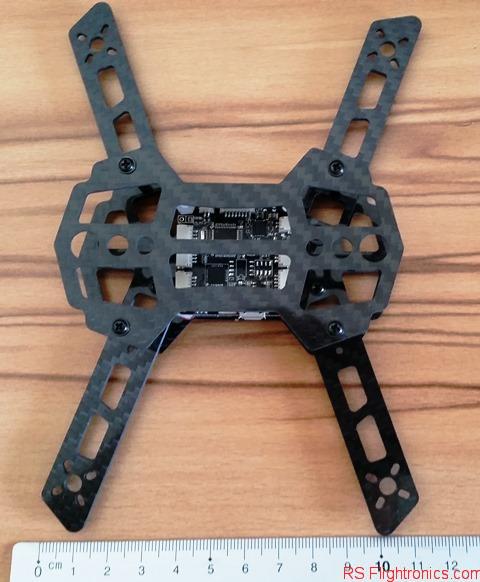
I have to say that when I received the frame I was a little skeptical about the thickness of the main body. I had the feeling that it was just fragile and that it would break at the minor incident…. good news: So far I haven’t had any issue with that. Once you mount and put all together, the setup seems to be robust enough to take regular crashes!
On the other hand, the arms thickness is more than acceptable and looks very robust.
ESCs
Taking into account that there is no much room for big ESCs in this setup, we should start ruling out most of the ESCs that are over 20 Amps. After all it wouldn’t make sense to think bigger than that since the little motors that fit this setup will certainly not go beyond the 20 Amps.
The DYS SN20A Mini 20A SimonK ESC OPTO looked like a good choice since the size was perfect. Another factor apart of the low price was that this ESC type doesn’t include a BEC, I find this typo of ESCs better than the one that comes with BECs for this two reasons
- Most of ESC will implement a lineal BEC. This kind of regulator will dissipate any the voltage difference as heat. This brings down the battery performance! The ESCs are already busy dissipating heat during the speed regulation process… why to bother them with additional stresses?
- They are isolated from the flight controller, this could be helpful in comparison with the regular ESCs since this isolation provides an additional grade of protection for the control side.

Motors
I noticed here that the options for the motors are a little bit more limited when talking about 1306 size. The DYS 1306 3100KV BX Series looked good to me. The comments were mostly good but there were no big differences when comparing the the Emax series.
One doesn’t realize how little this motors are until you have them in your hands!
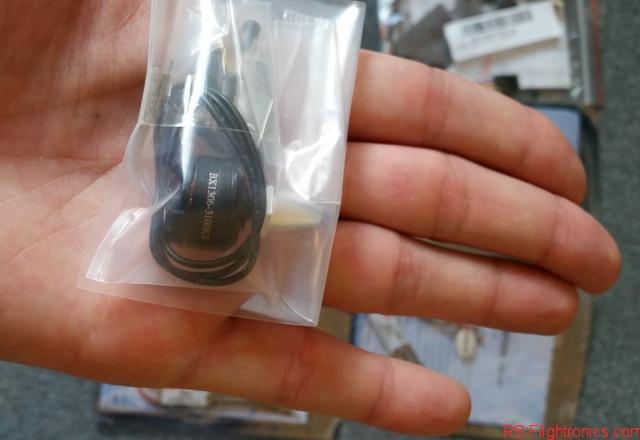
To my surprise, these little beasts perform (so far) just awesome!
Flight controller
The EMAX Skyline32 Naze32 Acro V2 brings everything you need for a mini racing quad for a good price. The key factor I saw on this controller is that JST-SH connector are used and the cable harnesses are provided. This makes a huge difference when it comes to save place! By using the regular 2,54mm connectors, I am not sure if it would be an easy task to find place for its big connectors…
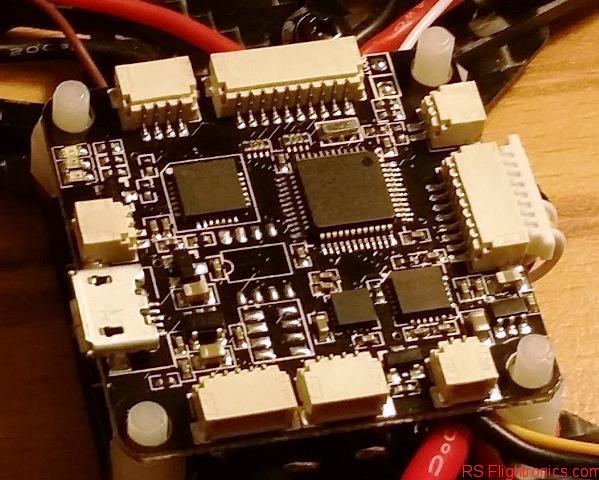
This flight controller is the equivalent of the well known Naze32 and can run Cleanflight or Betaflight with no problem. I also supports OSD (but it doesn’t mean that it includes one!!!!)
Video transmitter
Size as key-point again here. Also the fact of having race-band available would be an interesting plus. Since I am not planning to fly this little quad far away, the VTX power is a secondary factor for me. The Eachine ET200R FPV 5.8G 40CH 200mW Mini AV Transmitter with RaceBand covered all my expectations. It is great to see how small a VTX can be!

I specially like how simple is to change between channels and bands by only pressing one button. Once you get familiarized with the led array, the lecture of the current band and frequency is straight forward.
This little transmitter has worked with no problems in other setups, but for this current setup I am experiencing some fading issues after the transmitter has been running for a while. The problem get solved by changing the frequency.
I also noticed that the SMA connector gets very hot after some minutes. It could be the case that the antenna that I am using (a cheap one) is not that well impedance adapted and the signal that is being reflected is somehow causing the issue mentioned above. I will continue to try different variants an will bring some updates as soon as possible!
Quad assembly!
Some tips for the quad assembly
- Adapting the cables to a customized length helps to keep all organized.
- Consider getting some crimp contacts in case you have to assembly new cable harnesses.
- There is no enough room for cables between the ESC and the motor. Consider removing the ESCs motor cables and shortening the motor cables.
- If possible, avoid using the provided power distribution board. Its pad distribution is not convenient for the setup and the electronics is poorly designed. See further comments below. A switched PDB would be a much better choice!!!
- Make sure you don’t fix the ESCs and the motors until you have confirmed that the spinning direction is the right one for each motor. In case one motor is spinning in the wrong direction, swapping two of the ESC cables should fix the trouble.
- An additional hole is needed on the lower plate on the back side in order to place the antenna holder.
Some additional observations
It called my attention the way that the provided PDB was designed. Actually for the price one would think that this is ok. But actually when using 3s batteries the lineal regulators will have a hard time doing the voltage drop and dissipating the heat. When reading on the lineal regulator data sheet (LM7805) it is recommended to use some filter capacitors on the input and the output. Those capacitors were not implemented on the Diatone PDB. Another factor that I didnt like, is that both lineal regulators are connected in parallel… working as load for each other :/ .
I tested the performance of the Diatone PDB and after 5 minutes of regular use it would heat up quite a lot! I didn’t feel like trusting this as power supply for my flight controller and my camera. That is why I decided to go with a much better and optimized solution: a switched PDB. I used for some of my other setup the Matek Mini Power Hub PDB 5V/12V BEC V3 and only have good experiences with it. This is what I finally mounted into this setup.
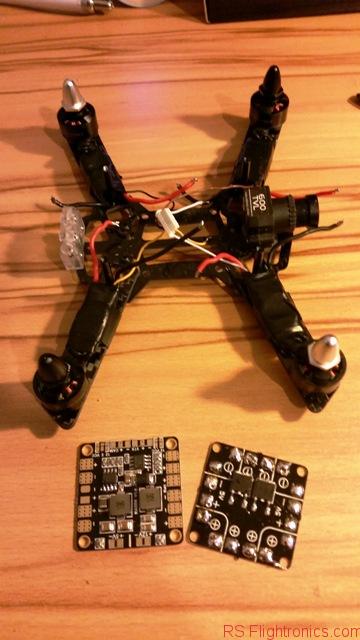
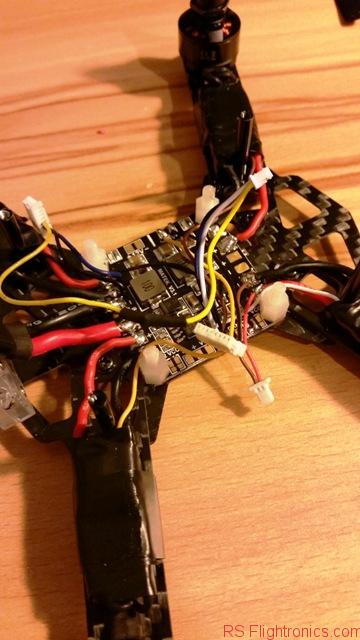
Test flight!
07/25/2016 – Update: Custom Motor mix
I noticed that the frame is not a perfect X as it is configured in Cleanflight. After doing some research, I arrive to the following values for the motor mixer. Below you can see the required CLI commands and the mmix values. Do not forget to run the “save” command when you are ready!
mixer custom mmix reset mmix 0 1 -1 0.682 -1 mmix 1 1 -1 -0.682 1 mmix 2 1 1 0.682 1 mmix 3 1 1 -0.682 -1 save
I haven’t tested these values yet, but I will be back with some comments about it!
Please subscribe and keep tuned for further updates! Your comments and questions are always welcome!












Do you have a video? I wanna see a fly because I gonna build a mini setup like this one
Hi Gabriel, I have just added a video to this post 😉
Hello!
I have the same components in my build (but using CC3D Atom instead NAZE) and after some flights, with a 3S Li-Po fully charged, I’m not able to increase altitude at max throttle. Checking the motors, seems to run very hot, too hot to touch. The ESCs remains cold.
Tested with 3 different batteries same result
2x 3S 11,1V 1300mAh 20C
1x 3S 11,1V 1500mAh 40C
In your build, your motors remains cold?
Hi Alex,
Have you already checked if there is a shortcircuit between the motors coil and the motrs screws?. For this you can use a multimeter and test for continuity between each screw and the connections on the ESC output. If you get to measure continuity with one or more screws use shorter screws or you could also use a plastic/ teflon washer.
I had a similar issue on the passt that was the cause. This would also explain why the motors get so hot.
Give it a try and let us know if this fixed your problem 😉
Hi RSF!
The things I did were:
Apply dry air spray on the motor coils. Testing with a multimeter I noticed that I was having electrical continuity between the frame separators (not tested between motor coils and motor screws)
I’m using PPM (one wire all channels).
The vcc + gnd + signal wires that goes from D4R-II receiver to CC3D were fixed to one of the separators with a small clamp. I removed the clamp (the wires are now “free”). After doing that I’m now flying smoothly.
Maybe I was having a shortcircuit between the motors coil and the motors screws and was solved after applying dry air into the motors or maybe magnetic induction from frame separator to signal wire while it was fixed to it.
I have no convincing explanation about how I solved my problem.
This other components will be fine for a Diatone 150 blade?
– DYS XM Series XM10A BLHeli mini 10A ESC. (Our DYS 1306 have max. current < 8A.)
– EMAX RS1306 3300KV
– What is the FPV camera in your build?
Thank you so much!